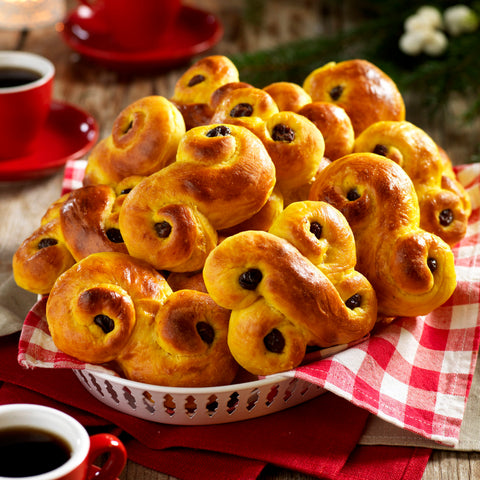Yesterday, the 13th of December was Luciadagen, St Lucy’s Day, a day mainly celebrated in Sweden, in Swedish-speaking areas of Finland and partly in Norway and Denmark. St Lucy’s Day commemorates Lucia of Syracuse, an early-4th-century virgin martyr who according to legend brought food and aid to Christians hiding in the Roman catacombs, wearing a candle lit wreath on her head to light her way and leave her hands free to carry as much food as possible. Her feast day, which coincided with the darkest day of the year prior to calendar reforms, is widely celebrated as a festival of light and in schools in Sweden children dress up as Lucia (and her little helpers) and sing songs about bringing light to the darkness (Lucia also means light). Lucia is not just for children though, in offices and other places all over Sweden people dress up, sing and most importantly: Eat lussekatter!
Lussekatter or saffron buns or saffron bread - is a sweet "bread" made from yeast, flour, sugar, milk and butter but with a very important twist- they're seasoned with saffron.
Lussekatter are traditionally eaten during Advent, and especially on St Lucy's Day but some people eat them in November and January as well. (Why not?)
Few of us however actually know that the golden buns have nothing to do with Lucia. Some theories mention that the buns were baked to prevent the devil from dressing up as a cat and spanking the children. The light buns, the yellow color and the shape of the bun would apparently keep Lusse (Lucifer) away...That’s a lot of drama for such a small bun!
The biggest drama surrounding the bun nowadays however, is the ever so important question: “Kesella or no Kesella?”
Kesella is Swedish quark – a mild soft cheese with a natural low fat content. Some people say it makes the buns juicier and tastier while other people say the opposite and even claim that the addition of Kesella to make the buns better is a complete myth. We’ve baked buns with and without Kesella and we honestly can’t say that there’s much of a difference. To us it’s more about the saffron (always add more than the recipe says for tastier buns is our pro tip)
Kesella or no Kesella, the season of the Lussekatt is here and we’ve added a recipe we think is great but before starting, here are some tips for those perfect golden buns:
- Use less flour and get a looser consistency than traditional wheat dough. Saffron dries out and requires more liquid. The dough should not be dry, not wet, but somewhere in between.
- Place milk, butter and eggs outside the fridge for a few hours before you start baking, it’s always better to bake with ingredients at room temperature.
- Mortar the saffron together with a little sugar and some alcohol, eg brandy. This helps to bring out the flavour of the saffron (and we love that!)
- Use more fat and sugar. The sugar benefits the yeast and the fermentation, and has a preservative effect. The fat makes the buns juicier.
- Freeze the lussekatter immediately after baking so you can enjoy them fresh every day.
You’ll need:
- 50 gr fresh yeast
- 1 gr saffron
- 0.5 teaspoon salt
- 200 gr butter
- 5 dl whole milk
- 1.5 dl caster sugar
- 1 egg (or 250 gr Kesella, it’s up to you. Let us know what you think works better)
- 1 kg (approx. 17 dl) flour
- Raisin for decoration (the eyes of the cat)
Gör såhär (do like this) for ca 32 lussekatter
- Mash the saffron with salt and a bit of alcohol in a mortar. If you don’t have alcohol, a splash of boiling water also works to bring out the flavour of the saffron.
- Melt the butter in a saucepan, add milk and sugar and heat to around 37C or as we say in Sweden “fingervarmt”.
- Put the yeast (in small pieces) into a bowl and pour over some of the milk mixture and stir until the yeast dissolves.
- Add the rest of the milk, saffron, egg (or Kesella) and most of the flour, save a little for the baking. Try to make sure not to use too much flour, that might make the buns too dry. Then work the dough in a baking machine or by hand for at least 10 min.
- Cover the dough and leave it to rise for an hour.
- Work the dough by hand some more and start rolling your buns into any shape, usually S-shaped.
- Place the the ready-rolled buns on a baking tray and leave them to rise further for about 45 min.
- Set the oven to 200C. Brush the buns with egg, add the raisins and then bake them in the middle of the oven for 6-8 min.
- Voila!- Your buns of light are ready to be served.


